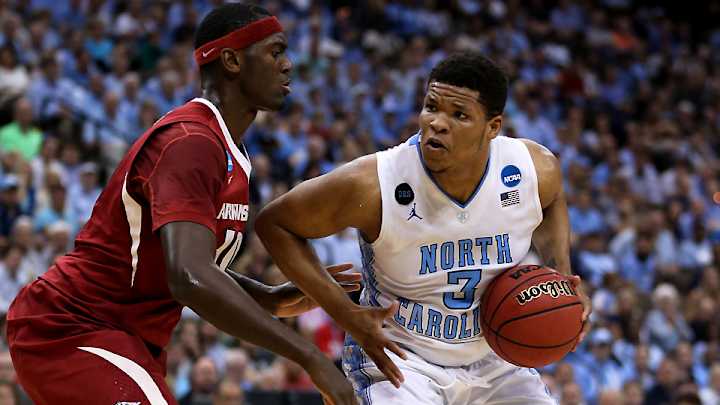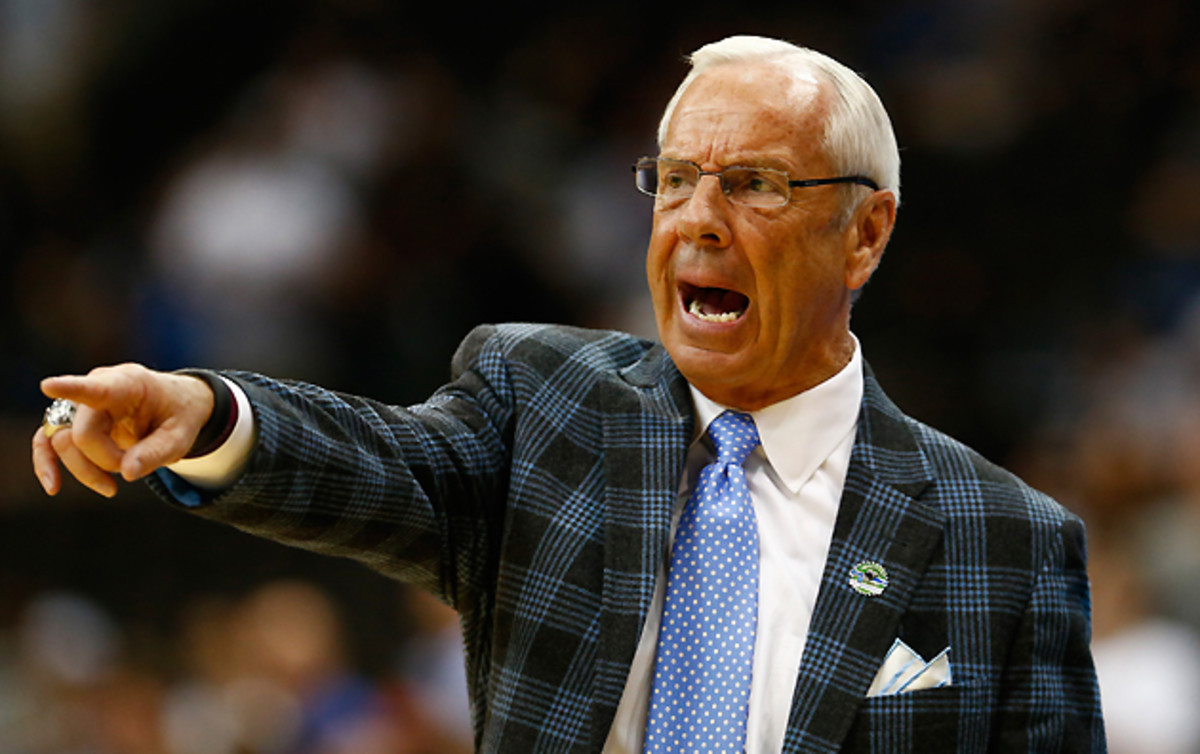UNC-Arkansas was the type of game college basketball needs more often

JACKSONVILLE, Fla.—North Carolina’s 87-78 win against Arkansas felt so much more entertaining than the Georgia State-Xavier game that preceded it, but why? It certainly wasn’t because of the brand-name teams. Georgia State was an infinitely better story than any of the other three teams that played in Jacksonville on Saturday, and Xavier’s 81.3% field goal shooting binge in the second half of its 75-67 win seemed as unbelievable as it was happening as it did when Georgia State coach Ron Hunter looked at that percentage on the stat sheet after the game and, even though he had been crying moments earlier, laughed.
So why did the heart race more watching the Tar Heels and Razorbacks? Why were there more ooohs and ahhs and screams from the stands? The answer was buried on the stat monitor. Georgia State and Xavier combined for 113 possessions. Arkansas and North Carolina combined for 158. Georgia State and Xavier combined to take 80 shots. Arkansas and North Carolina combined to take 125. A casual viewer probably got six interesting minutes from the first game. That same viewer got about 38 interesting minutes from the second. It felt different because the Tar Heels and Razorbacks were playing an entirely different sport than the Panthers and Musketeers.
East region shakeup, Pac-12 surprise overshadow Kentucky—for a day
“That's what you want in a college basketball game,” Arkansas coach Mike Anderson said. “I was looking forward to the opportunity to get up and down the floor and guys not holding the basketball. They attacked us. Guess what? We attacked them as well.”
College basketball’s problem is that too many teams play like Georgia State and Xavier and not enough play like Arkansas and North Carolina. Saturday, the Hogs and Heels played as if they would get zapped if they didn’t shoot in the first 18 seconds of each possession. In the first half, before the officials decided everyone was having waaaaay too much fun and started blowing whistles, the teams raced up and down the court. They dunked. They swatted shots. They forced steals in the backcourt. They didn’t always play technically perfect basketball, but something was always happening. That isn’t the case in a lot of college basketball games in 2015.
If you haven’t read the call to action co-worker Seth Davis wrote earlier this month, do it now. (Don’t worry. I’ll still be here when you finish.) In that story, Davis meticulously lays out the reasons the game is suffering as a spectator sport—slow, grinding offenses, poor recognition by officials in block/charge situations and rule enforcement that allows the game to get bogged down. Field goal percentage, possessions and scoring continue to trend down, making the game more boring every year. Davis also offers some potential solutions—shorten the shot clock, move the block/charge arc, widen the lane, move the three-point line back and take away timeouts. Anyone who watched men huddle for an eternity at end of regulation in Butler-Notre Dame early Sunday morning would certainly appreciate that last one.
The Treaty of Versailles didn't require this much discussion.
— John Gasaway (@JohnGasaway) March 22, 2015
The first half of Arkansas-North Carolina—when the officials called 17 fouls as opposed to the 31 they called in the second—was the solution. The teams didn’t pack the lane. They ran. They pressed. They didn’t run interminable offensive sets. They attacked the basket and took the first open shot they could get. Sometimes that shot wasn’t so open, and the ball got swatted into the second row. That was entertaining as well. It was as if the Razorbacks and Tar Heels remembered this is a spectator sport, and it’s supposed to be fun.
On ESPN’s Grantland.com, Brian Phillips published an excellent column Friday that touched on many of the same themes Davis did earlier this month. “NCAA men’s basketball,” Phillips writes, “is a brutal grind, a low-scoring, conservative game dominated by clampdown defense and half-court sets that look like they’re being run on wet sand.” Later, Phillips describes this brand of basketball as “like being slowly dissolved in the stomach of an anaconda.” Neither statement is unfair.
Phillips posits that the NCAA won’t do anything too drastic to liven up the game because that would be a tacit admission that men’s basketball is a spectator sport and a product to be sold to television networks and ticket buyers. In these litigious times, Phillips reasons, the NCAA wouldn’t dare make this admission when its attorneys are busy claiming in federal court that these sports only exist to build up young men and women through kisses from magical amateurism unicorns.

I disagree with Phillips for a few reasons. First, the schools make the rules and not some shadowy cabal in Indianapolis. In this case, a committee of basketball coaches and basketball-centric administrators make the playing rules. Even if NCAA brass wanted to stop the committee from changing the rules, it probably couldn’t. Second, the schools have monkeyed with the rules in football, which brings in far more money than basketball, for the express purpose of making it a more palatable product for television networks and spectators.
In the past nine years, the football rules committee has made two major sets of changes to the rules concerning pace of play. The first had disastrous consequences. The second had another set of unintended consequences that wound up making the on-field product a lot more interesting. In 2006, the football rules committee adjusted the clock rules to cut the total running time of games. It succeeded in that, slicing the average game from three hours, 21 minutes in 2005 to three hours, seven minutes in 2006. But it also lopped an average of 13 plays, 66 offensive yards and five points off each game. The committee had failed to understand that people who like football didn’t want less football. So the rules were scrapped prior to the 2007 season.
The committee changed the rules again prior to 2008, adopting the same play clock—football’s version of the shot clock—as the NFL. Before, the scoreboard operator waited while an official sauntered or sprinted (depending on the official) to set the ball at the line of scrimmage and gave the ready for play signal. This started a 25-second clock. Under the rule that went into effect in 2008, a 40-second clock begins ticking at the end of each play. The idea was to create a more uniform pace of play. That’s not exactly what happened.
N.C. State players used rollercoaster year as motivation to upset Villanova
Some smart offensive coaches noticed that this change would allow their offenses to play much faster. Once the official set the ball, they could snap it. So Oregon’s Chip Kelly, Baylor’s Art Briles, Texas Tech’s Mike Leach, Tulsa’s Gus Malzahn and others ordered their offenses to snap the ball as quickly as humanly possible. This made officials move faster and allowed offenses to run even more plays without giving defenses time to adjust or substitute. The rise of hurry-up, no-huddle offenses has provided a fascinating wrinkle, and it has captivated the casual fan who likes to see scoring and wild swings.
The basketball rules committee also could change the structure of the game to make it more interesting. The structural changes Davis suggested probably would work better than tightening rules on contact, which would lead to more fouls, more free throws and more stoppages in play until coaches learned to train their players differently. Dropping the shot clock to 30 seconds would help more. Dropping it to the NBA’s 24 might be even better. Widening the lane would prevent the clogs that limit post scorers and slashing guards now. Moving back the three-point line wouldn’t hurt shooters as much as it would loosen up the area inside the arc by forcing defenders to come out and guard offensive players stationed just beyond the arc. Widening the block/charge arc in the lane would discourage defenders from camping out solely to draw a charge. No one is asking coaches to turn into Paul Westhead at Loyola Marymount or copy Division III Grinnell’s chuck-and-duck system. Just pick up the pace a little and have some fun.
If the committee needs any guidance, members should call up a video of Saturday’s first half between Arkansas and North Carolina. After they wipe the smiles off their faces, they’ll have an idea where to aim with their tweaks. “The Rules Committee, I was on there for six years and loved it, but I felt a great deal of responsibility,” UNC coach Roy Williams said. “And I think that we all need to look at things we can do to perhaps speed things up or make it a more free-flowing game. But I think everyone agrees that we need to do that.”
Of course, Williams might be on the extreme end. “But just because Roy Williams likes something doesn't mean it's the best thing for the game,” Williams said. “I mean, if it was up to me, we'd have a 15-second clock. It would really be fun then.”
